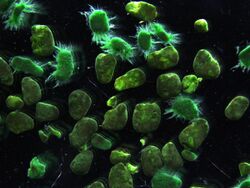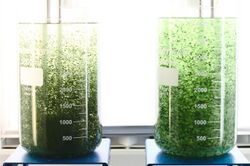Engineering:Oxygenic photogranules
Oxygenic photogranules (OPGs) are a type of biological aggregate with an approximately spherical form, typically from a millimeter to a centimeter scale. OPGs are characterized by the cloth-like layer of phototrophic organisms, predominantly filamentous cyanobacteria of the order Oscillatoriales. Oxygen production by these phototrophs through photosynthesis is typically coupled to oxygen consumption of heterotrophic biomass, releasing CO2 that is presumably utilised in a syntrophic relationship by autotrophic phototrophs.
Discovery/Context
In 2011, Park and Dolan first observed the transformation of activated sludge into oxygenic photogranule (OPG).,[1] when incubated in unagitated and sealed vials exposed to natural light for several months. Since then, this static cultivation of OPG was observed with activated sludge coming from various places over the world[2] in several laboratories ([4],[5],[6],[7],[8] etc.).
OPGs were discovered recently and serendipitously in laboratory conditions, but very similar granules, called cryoconites, are found in glaciers[3]
Formation of oxygenic photogranules
Anaerobic and aerobic granule formation are typically postulated to be driven by hydrodynamic shear and washout. Oxygenic photogranules do form when exposed to hydrodynamic shear in sequencing batch reactors;[4] however, they also form under static batch[1]&.[2] They can form over the course of several weeks from a source of activated sludge exposed to light. How oxygenic photogranules form is far from understood, but filamentous and motile cyanobacteria seem to play an essential role in their formation. Cyanobacteria are enriched from the activated sludge and form the outer layer of photogranules that gives structural integrity for both photogranules generated under hydrodynamic and static conditions.[2]
This hypothesis is supported by the finding that the initial presence of inorganic nitrogen in the activated sludge inoculum promotes cyanobacterial growth over microalgal growth, resulting in successful oxygenic photogranules.[5]
Oxygenic photogranule formation is thus not driven by hydrodynamic shear and washout are not required for the formation of oxygenic photogranules, even though these factors may play an important role when applied. Filamentous, motile cyanobacteria play a key role, but exact mechanisms have to be elucidated to be able to control the formation and properties of oxygenic photogranules and apply them to bioengineering processes.
Oxygenic photogranules applied to wastewater treatment
Oxygenic photogranules is a new type of biogranules that has not been applied in bioengineering processes yet.[6] but has promising potentials to be applied in wastewater treatment. OPG have been applied in turbulently mixed sequencing batch reactors SBR and in high rate algal pond.[7] Oxygenic photogranules have the ability to couple oxygen production through photosynthesis to conversion of organic matter into carbon dioxide by heterotrophs. Therefore, they have the potential to treat wastewater without external source of aeration[4] and to generate energy when this biodegradable biofeedstock is used for anaerobic digestion[7]
References
- ↑ 1.0 1.1 Park C, Dolan S. Algal-sludge granule for wastewater treatment and bioenergy feedstock generation. Patent Cooperation Treaty WO 2015112654 A2, 2015. [1]
- ↑ 2.0 2.1 2.2 Milferstedt, K., Kuo-Dahab, W.C., Butler, C.S., Hamelin, J., Abouhend, A.S., Stauch-White, K., McNair, A., Watt, C., Carbajal-González, B.I., Dolan, S., Park, C., 2017. The importance of filamentous, motile cyanobacteria in the development of oxygenic photogranules. Sci. Reports. 7, 17944. doi:10.1038/s41598-017-16614-9 [2]
- ↑ Christner, B.C., Kvitko, B.H., Reeve, J.N., 2003. Molecular identification of Bacteria and Eukarya inhabiting an Antarctic cryoconite hole. Extremophiles 7, 177–183. doi:10.1007/s00792-002-0309-0
- ↑ 4.0 4.1 {{ Abouhend AS, McNair A, Kuo-Dahab WC, Watt C, Butler CS, Milferstedt K, Hamelin J, Seo J, Gikonyo GJ, El-Moselhy KM, Park C. 2018. The oxygenic photogranule process for aeration-free wastewater treatment. Environ. Sci. Technol.,• DOI:10.1021/acs.est.8b00403}}
- ↑ Stauch-White, K., Srinivasan, V. N., Kuo-Dahab, W. C., Park, C. & Butler, C. S. The role of inorganic nitrogen in successful formation of granular biofilms for wastewater treatment that support cyanobacteria and bacteria. AMB Express 7, 146 (2017). [3]
- ↑ Milferstedt, K., Hamelin, J., Park, C., Jung, J., Hwang, Y., Cho, S.K., Jung, K.W., Kim, D.H., 2017. Biogranules applied in environmental engineering. International Journal of Hydrogen Energy in press. doi:10.1016/j.ijhydene.2017.07.176
- ↑ 7.0 7.1 Arcila, J.S., Buitrón, G., 2016. Microalgae–bacteria aggregates: effect of the hydraulic retention time on the municipal wastewater treatment, biomass settleability and methane potential. J. Chem. Technol. Biotechnol. 91, 2862–2870. doi:10.1002/jctb.4901
External links
- http://www6.montpellier.inra.fr/narbonne_eng/Research-themes/Photogranules
- http://cee.umass.edu/environmental-water-resources-engineering
- http://www.mhtc.ro/national-research-development-institute-industrial-ecology
- http://www.iingen.unam.mx/es-mx/BancodeInformacion/Entrevistas/Paginas/GermanBuitronMendez.aspx
- https://www.researchgate.net/profile/Dong-Hoon_Kim
 |






